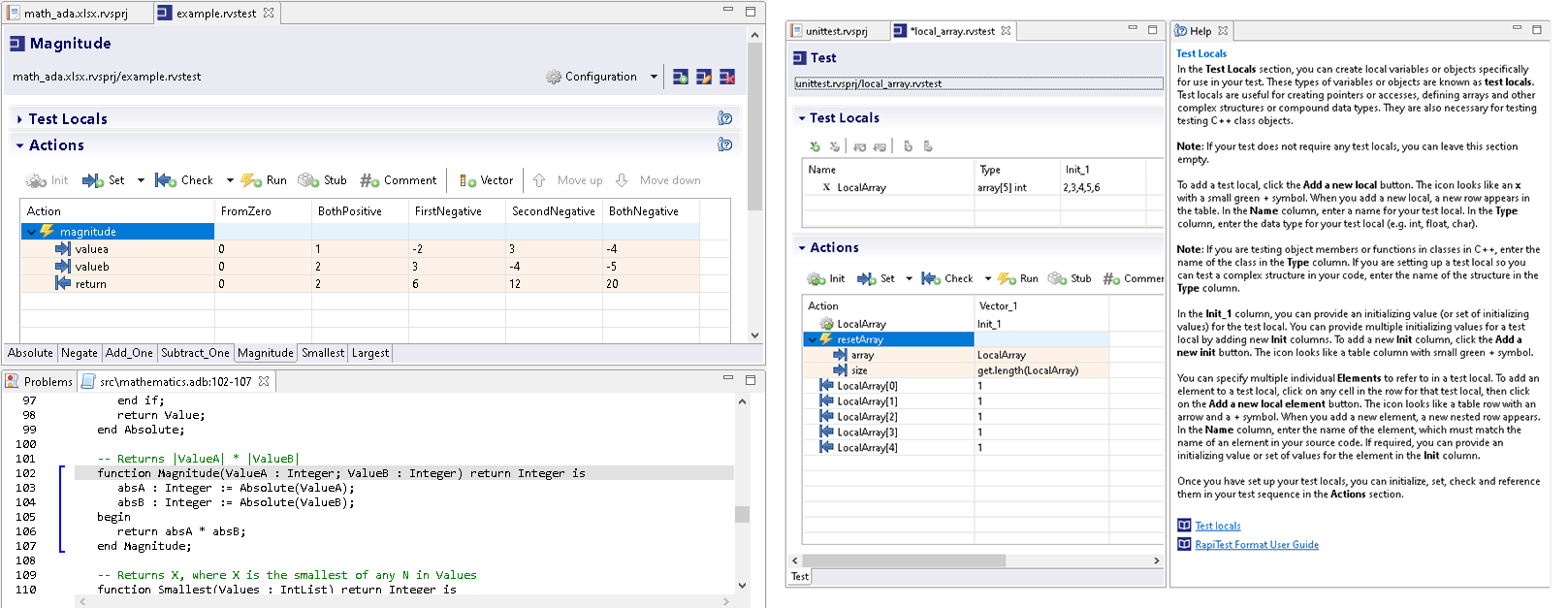As test authoring and review take a large amount of overall effort in requirements-based testing projects, the efficiency of these activities is important. We’ve been thinking about how we can improve the efficiency of these activities in RapiTest recently, and that’s why we’ve been developing a new testing format that lets you write your tests directly in the RVS Project Manager.
Edit: The first official version of the RapiTest Editor (shown in the video above) was released in RVS 3.16, after the publication of this blog.
RapiTest currently supports two native testing formats: an easy-to-read spreadsheet-based testing format, and a scripting format (Figure 1). The former makes the test-writing experience easier and more accessible for people who are unfamiliar with scripting languages, while the latter supports writing more complex tests with features such as conditional logic. As well as these native formats, RapiTest supports a variety of third-party formats.
For the last few months, we’ve been developing and testing a third native testing option that lets you write tests directly in the RVS Project Manager, known as the RapiTest Editor. As the new test editor is intimately coupled with our UI, this has enabled us to develop the format with a range of benefits that can reduce test authoring and reviewing effort (Figure 2):
- Automatic test framework generation based on selection of a unit under test.
- Both syntactic and semantic error highlighting – while our scripting format offers syntactic error highlighting, we can go one step further with this format and highlight semantic errors as well.
- Viewing expected and achieved results alongside your tests – this makes it easier to fix failing tests.
- Context-sensitive help – the new format offers a more guided user experience, making it clearer what the next step is and easier to access documentation.
- Consistent formatting for readability – test layout and formatting is handled automatically, making all tests consistent.
The RapiTest Editor is still under development, and we plan to release the first official version in RVS 3.16. If you’re an existing RapiTest customer and want to test it before then, contact us and we’ll share a wavefront version so you can try it out.
Update on the latest developments in flexible test authoring in RapiTest can be found below:
RapiTest now gives you flexibility in writing your tests by providing three testing options: the RapiTest Editor format, which is integrated into the RapiTest user-interface, a spreadsheet format and a scripting language.

 Rapita System Announces New Distribution Partnership with COONTEC
Rapita System Announces New Distribution Partnership with COONTEC
 Rapita partners with Asterios Technologies to deliver solutions in multicore certification
Rapita partners with Asterios Technologies to deliver solutions in multicore certification
 SAIF Autonomy to use RVS to verify their groundbreaking AI platform
SAIF Autonomy to use RVS to verify their groundbreaking AI platform
 RVS gets a new timing analysis engine
RVS gets a new timing analysis engine
 How to measure stack usage through stack painting with RapiTest
How to measure stack usage through stack painting with RapiTest
 What does AMACC Rev B mean for multicore certification?
What does AMACC Rev B mean for multicore certification?
 How emulation can reduce avionics verification costs: Sim68020
How emulation can reduce avionics verification costs: Sim68020
 How to achieve multicore DO-178C certification with Rapita Systems
How to achieve multicore DO-178C certification with Rapita Systems
 How to achieve DO-178C certification with Rapita Systems
How to achieve DO-178C certification with Rapita Systems
 Certifying Unmanned Aircraft Systems
Certifying Unmanned Aircraft Systems
 DO-278A Guidance: Introduction to RTCA DO-278 approval
DO-278A Guidance: Introduction to RTCA DO-278 approval
 Avionics Certification Q&A: CERT TALK (with Consunova and Visure)
Avionics Certification Q&A: CERT TALK (with Consunova and Visure)

















